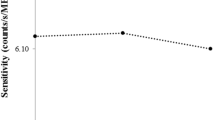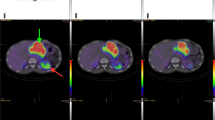Abstract
Purpose
In recent years, targeted radionuclide therapy with [177Lu-DOTA0, Tyr3]octreotate for neuroendocrine tumours has yielded promising results. This therapy may be further improved by using individualized dosimetry allowing optimization of the absorbed dose to the tumours and the normal organs. The aim of this study was to investigate the feasibility and reliability of individualized dosimetry based on SPECT in comparison to conventional planar imaging.
Methods
Attenuation-corrected SPECT data were analysed both by using organ-based volumes of interest (VOIs) to obtain the total radioactivity in the organ, and by using small VOIs to measure the tissue radioactivity concentration. During the first treatment session in 24 patients, imaging was performed 1, 24, 96 and 168 h after [177Lu-DOTA0, Tyr3]octreotate infusion. Absorbed doses in non tumour-affected kidney, liver and spleen were calculated and compared for all three methods (planar imaging, SPECT organ VOIs, SPECT small VOIs).
Results
Planar and SPECT dosimetry were comparable in areas free of tumours, but due to overlap the planar dosimetry highly overestimated the absorbed dose in organs with tumours. Furthermore, SPECT dosimetry based on small VOIs proved to be more reliable than whole-organ dosimetry.
Conclusion
We conclude that SPECT dosimetry based on small VOIs is feasible and more accurate than conventional planar dosimetry, and thus may contribute towards optimising targeted radionuclide therapy.






Similar content being viewed by others
References
Virgolini I, Britton K, Buscombe J, Moncayo R, Paganelli G, Riva P. In- and Y-DOTA-lanreotide: results and implications of the MAURITIUS trial. Semin Nucl Med 2002;32:148–55.
Bodei L, Cremonesi M, Grana C, Rocca P, Bartolomei M, Chinol M, et al. Receptor radionuclide therapy with 90Y-[DOTA]0-Tyr3-octreotide (90Y-DOTATOC) in neuroendocrine tumours. Eur J Nucl Med Mol Imaging 2004;31:1038–46.
Kwekkeboom DJ, Mueller-Brand J, Paganelli G, Anthony LB, Pauwels S, Kvols LK, et al. Overview of results of peptide receptor radionuclide therapy with 3 radiolabeled somatostatin analogs. J Nucl Med 2005;46:62S–6.
Kwekkeboom DJ, Teunissen JJ, Bakker WH, Kooij PP, de Herder WW, Feelders RA, et al. Radiolabeled somatostatin analog [177Lu-DOTA0,Tyr3]octreotate in patients with endocrine gastroenteropancreatic tumors. J Clin Oncol 2005;23:2754–62.
Valkema R, Pauwels S, Kvols LK, Barone R, Jamar F, Bakker WH, et al. Survival and response after peptide receptor radionuclide therapy with [90Y-DOTA0]octreotide in patients with advanced gastroenteropancreatic neuroendocrine tumors. Semin Nucl Med 2006;36:147–56.
Kwekkeboom DJ, de Herder WW, Kam BL, van Eijck CH, van Essen M, Kooij PP, et al. Treatment with the radiolabeled somatostatin analog [177Lu-DOTA0, Tyr3]octreotate: toxicity, efficacy and survival. J Clin Oncol 2008;26:2124–30.
Moll S, Nickeleit V, Mueller-Brand J, Brunner FP, Maecke HR, Mihatsch MJ. A new cause of renal thrombotic microangiopathy: yttrium 90-DOTATOC internal radiotherapy. Am J Kidney Dis 2001;37:847–51.
Cybulla M, Weiner SM, Otte A. End-stage renal disease after treatment with 90Y-DOTATOC. Eur J Nucl Med 2001;28:1552–4.
Kwekkeboom DJ, Bakker WH, Kooij PP, Konijnenberg MW, Srinivasan A, Erion JL, et al. [177Lu-DOTAOTyr3]octreotate: comparison with [111In-DTPA0]octreotide in patients. Eur J Nucl Med 2001;28:1319–25.
Cremonesi M, Ferrari M, Bodei L, Tosi G, Paganelli G. Dosimetry in peptide radionuclide receptor therapy: a review. J Nucl Med 2006;47:1467–75.
Wehrmann C, Senftleben S, Zachert C, Müller D, Baum RP. Results of individual patient dosimetry in peptide receptor radionuclide therapy with 177Lu DOTA-TATE and 177Lu DOTA-NOC. Cancer Biother Radiopharm 2007;22:406–16.
Stabin M. Fundamentals of nuclear medicine dosimetry. Springer. 2008; ISBN 978-0-387-74578-7.
Barone R, Borson-Chazot F, Valkema R, Walrand S, Chauvin F, Gogou L, et al. Patient-specific dosimetry in predicting renal toxicity with 90Y-DOTATOC: relevance of kidney volume and dose rate in finding a dose-effect relationship. J Nucl Med 2005;46 (Suppl 1):99S–106S.
Konijnenberg M, Melis M, Valkema R, Krenning E, de Jong M. Radiation dose distribution in human kidneys by octreotides in peptide receptor radionuclide therapy. J Nucl Med 2007;48:134–42.
Chowdhury FU, Scarsbrook AF. The role of hybrid SPECT-CT in oncology: current and emerging clinical applications. Clin Radiol 2008;63(3):241–51.
Ljungberg M, Frey E, Sjogreen K, Liu X, Dewaraja Y, Strand SE. 3D absorbed dose calculations based on SPECT: evaluation for 111In/90Y therapy using Monte Carlo simulations. Cancer Biother Radiopharm 2003;18:99–107.
Forrer F, Krenning EP, Kooij PP, Bernard BF, Konijnenberg M, Bakker WH, et al. Bone marrow dosimetry in peptide receptor radionuclide therapy with [177Lu-DOTA0,Tyr3]octreotate. Eur J Nucl Med Mol Imaging 2009;36:e-pub ahead of print.
Flemming JS. A technique for absolute measurement of activity using a gamma camera and computer. Phys Med Biol 1979;24:176–80.
Leide-Svegborn S. Radiation exposure of the patient in nuclear medicine. Experimental studies of the biokinetics of 111In-DTPA-D-Phe1-octreotide, 99mTc-MIBI, 14C-triolein and 14C-urea and development of dosimetric models. Dissertation: Lund University, 1999.
ICRP. ICRP Publication 23. Reference man: anatomical, physiological and metabolic characteristics. Elsevier; 1975.
Stabin M, Siegel J, Lipsztein J, et al. RADAR (RAdiation Dose Assessment Resource). http://www.doseinfo-radar.com/RADARphan.html. Accessed 14 July 2009.
Williams LE, DeNardo GL, Meredith RF. Targeted radionuclide therapy. Med Phys 2008;35:3062–8.
Stabin MG, Sparks RB, Crowe E. OLINDA/EXM: the second-generation personal computer software for internal dose assessment in nuclear medicine. J Nucl Med 2005;46:1023–7.
Bernhardt P, Ahlman H, Forssell-Aronsson E. Modelling of metastatic cure after radionuclide therapy: influence of tumor distribution, cross-irradiation, and variable activity concentration. Med Phys 2004;31:2628–35.
Valkema R, Pauwels S, Kvols LK, Kwekkeboom DJ, Jamar F, de Jong M, et al. Long-term follow-up of renal function after peptide receptor radiation therapy with 90Y-DOTA0, Tyr3-octreotide and 177Lu-DOTA0, Tyr3-octreotate. J Nucl Med 2005;46:83S–91.
Acknowledgments
The authors would like to express their gratitude to Professor Eric Krenning and Professor Dik Kwekkeboom, for generously sharing their experience and the peptide supply. They also wish to thank the staff at the Divisions of Nuclear Medicine and Endocrine Oncology (78D), Uppsala University Hospital, for their friendly assistance.
Author information
Authors and Affiliations
Corresponding author
Rights and permissions
About this article
Cite this article
Sandström, M., Garske, U., Granberg, D. et al. Individualized dosimetry in patients undergoing therapy with 177Lu-DOTA-D-Phe1-Tyr3-octreotate. Eur J Nucl Med Mol Imaging 37, 212–225 (2010). https://doi.org/10.1007/s00259-009-1216-8
Received:
Accepted:
Published:
Issue Date:
DOI: https://doi.org/10.1007/s00259-009-1216-8




